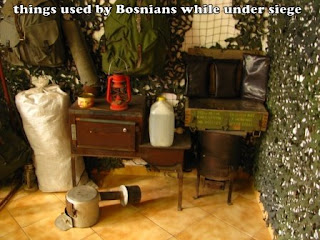Of course, Sarajevo is not all about the Old Town. You cannot say you’ve been to Sarajevo if all you had done is to hang out in the Old Town the whole day. If you want to know what Sarajevo or for that matter, Bosnia & Hercegovina is all about, you have to walk out of the old town. The hostel actually provides a half day tour of the city, which only cost 25 SGD, allowing one to get to know more about the history and the city itself. Bosnia & Hercegovina consists of Serbians, Croats and Muslim Bosnians. In the early 90’s, the Croats and Bosnians stood up against Serbian nationalists, and in October 1991, they managed to gain independence from the Serbians. 6 months later, the big siege started. Serbian forces made used of the huge resources of the Yugoslavian army and moved into Bosnian territories. Making full use of the environment, Serbian forces placed their tanks on the hills surrounding Sarajevo. For the next three years, Serbian forces bombarded Sarajevo with their tanks and grenade. On top of that, they placed snipers on strategic positions on the hills and shot at random. As long as something moved or it was a building that caught the Serbians fancy, it was bound to be hit. The Bosnians do not have huge supply of artillery like the Serbians did, neither was the army as huge as their enemy, thus there was no way they could retaliate. Instead, one could count their lucky stars if they managed to avoid being hit. We asked our guide, why did the Serbians only besieged the city, but not moved in to take control? The tour guide, who was one of those who had suffered under the hands of Serbians, said with an air of resignation,” Who knows? Maybe right from the start, they had never wanted to bring us under their rule, but just want to toy with us.”
 我们先到内战时期当地人为了生存而挖的一个地道去看。当时由于萨拉热窝全面被包围,食粮成了最大的问题。最后他们选择了在某个村子的其中一个家挖掘地道,通往到没有塞尔维亚军人攻击的角落,以便能够购买食物和水。挖掘这个地道一点也不简单,因为除了要避开塞尔维亚人的眼目外,地道要通过当地的唯一机场,而这里当然是塞尔维亚军人轰炸最猛的地方。结果当地人花了一年多的时间,才将这个长达800米,高1米60的地道挖好。地道在战争后坍塌了,所以现在只有部分地道开放给人参观。这一家的主人非常慷慨地把房子改成博物馆,让人能够多了解当时的战争和这个地道的作用。除了墙壁上的枪洞外,你还可以在地上看到手榴弹的痕迹,显示就连这里在当时也不安全。
我们先到内战时期当地人为了生存而挖的一个地道去看。当时由于萨拉热窝全面被包围,食粮成了最大的问题。最后他们选择了在某个村子的其中一个家挖掘地道,通往到没有塞尔维亚军人攻击的角落,以便能够购买食物和水。挖掘这个地道一点也不简单,因为除了要避开塞尔维亚人的眼目外,地道要通过当地的唯一机场,而这里当然是塞尔维亚军人轰炸最猛的地方。结果当地人花了一年多的时间,才将这个长达800米,高1米60的地道挖好。地道在战争后坍塌了,所以现在只有部分地道开放给人参观。这一家的主人非常慷慨地把房子改成博物馆,让人能够多了解当时的战争和这个地道的作用。除了墙壁上的枪洞外,你还可以在地上看到手榴弹的痕迹,显示就连这里在当时也不安全。We first visited a tunnel that was dug by the Bosnians during the war. As Bosnia was fully surrounded by the Serbian forces, food became a problem. In the end, they made use of a house in the village next to the air field, and dug a tunnel that went under the air strip, into where Serbian forces cannot reach, and bought food and other supplies brought there by the Croats. Since this area was beside the airport, this of course was heavily shelled by the Serbians. As such, it took the Bosnians more than a year to dig this 800m long and only 1.6m wide tunnel. Part of the tunnel collapsed after the war ended, but the undamaged part is open for public viewing. The owner of the house which was used as the entrance to the tunnel has very kindly agreed to convert the house into a museum, where one can get to understand more about the war. Other than the bullet holes on the wall of the house, you can still see parts of grenade stuck onto the floor, indicating how dangerous it must have been for the men who worked on the tunnel.





 之后我们到山上去。从高处往下去,你可以清楚地了解到塞尔维亚人当初为何会选择这样的一个战略,你也可以想象萨拉热窝人是如何度过那恐怖的三年。
之后我们到山上去。从高处往下去,你可以清楚地了解到塞尔维亚人当初为何会选择这样的一个战略,你也可以想象萨拉热窝人是如何度过那恐怖的三年。Next, we head for the mountains, from which you can see the whole city and get a good idea of how the Serbians could successfully besiege Sarajevo for so long.
 看到下列图中左下角那鲜黄色的建筑吗?那就是著名的假日酒店。当年塞尔维亚人拼命地炮轰萨拉热窝,但就只有这家酒店没有事。结果这里就成了世界各地记者的大本营,他们成天窝在这家酒店,将前线的报道传回自己的报馆。他们并不能随便出去走动,因为假日酒店后边的小巷是著名的狙击手巷,塞尔维亚狙击手特别喜爱拿这个巷子当射靶场,凡是在这个巷子会动的东西都会被射中。
看到下列图中左下角那鲜黄色的建筑吗?那就是著名的假日酒店。当年塞尔维亚人拼命地炮轰萨拉热窝,但就只有这家酒店没有事。结果这里就成了世界各地记者的大本营,他们成天窝在这家酒店,将前线的报道传回自己的报馆。他们并不能随便出去走动,因为假日酒店后边的小巷是著名的狙击手巷,塞尔维亚狙击手特别喜爱拿这个巷子当射靶场,凡是在这个巷子会动的东西都会被射中。See the yellow building in the picture below? That is the famous Holiday Inn where all the foreign reporters stayed in as they reported on the war, as this was the only building left unharmed. However, the reporters could not move around freely in the city as the alley behind the hotel was the famous snipers’ alley, which was the favorite shooting ground of the Serbian snipers.

 其实我们所处的位置正是1984年冬季奥运会的比赛场地。对啊,萨拉热窝就是以主办那一年冬奥运为名。我们去的那一座山正是雪橇的赛场。这里以前可热闹了,有漂亮的酒店和餐厅,有个缆车连接萨拉热窝古镇和这里。可是随着战争,这些餐厅和酒店已经成为废墟,缆车早已没有了踪迹,留下的只是支撑缆车的柱子的根基。这里以后也很难再有缆车,因为塞尔维亚人当时在萨拉热窝四周埋下了许多地雷,到今天都还没有清除。当年不少世界闻名的运动员划下的雪橇,现在已经成为当地年轻人涂鸦的地方了。
其实我们所处的位置正是1984年冬季奥运会的比赛场地。对啊,萨拉热窝就是以主办那一年冬奥运为名。我们去的那一座山正是雪橇的赛场。这里以前可热闹了,有漂亮的酒店和餐厅,有个缆车连接萨拉热窝古镇和这里。可是随着战争,这些餐厅和酒店已经成为废墟,缆车早已没有了踪迹,留下的只是支撑缆车的柱子的根基。这里以后也很难再有缆车,因为塞尔维亚人当时在萨拉热窝四周埋下了许多地雷,到今天都还没有清除。当年不少世界闻名的运动员划下的雪橇,现在已经成为当地年轻人涂鸦的地方了。The mountain where we were on was actually one of the venues for the Winter Olympics in 1984. Yep, you didn’t read wrong. This war ravage city was actually once the host city for the biggest winter sports games. This mountain was the venue for the bobsleigh competition. In its heyday, this mountain was filled with beautiful hotels and restaurants. There was even a cable car connecting the city to the mountain top. Nowadays, all one could see of the hotels and restaurants are just ruins. As for the cable car, one can only see the stumps of the pillars supporting the ropeway. And what became of the bobsleigh arena? It is now a drawing board for “budding” artists. 







 问导游为何隔了十多年,这些满目疮痍的建筑还在,不将它们拉倒重建?导游说:“还不是因为没有钱!知道我们目前的就业率是多少吗?有多达六成的人是失业人士。”说实在的,要不是有个导游为我们讲解,看着现在的波黑,你根本很难想象那一段黑暗的日子。
问导游为何隔了十多年,这些满目疮痍的建筑还在,不将它们拉倒重建?导游说:“还不是因为没有钱!知道我们目前的就业率是多少吗?有多达六成的人是失业人士。”说实在的,要不是有个导游为我们讲解,看着现在的波黑,你根本很难想象那一段黑暗的日子。We asked the tour guide why is it that so many of the ruined buildings are still left standing more than 10 years after the war. The tour guide replied, "What else but money? Do you know what the unemployment rate in this country is like? As much as 60% of the population is unemployed. Where would we find the money to rebuild everything then?" Frankly speaking, if not for the guide pointing things out and explaining things to us, it is really hard to imagine the dark days of the war, given how beautiful this country is.



1 comment:
i cant help but reflect and think how fortunate we really are - having came back from Lebanon a month ago and now reading your blog on the Bosnian war..
Post a Comment